A redefinição da senha do WordPress geralmente é um processo simples. No entanto, às vezes os métodos padrão não funcionam, fazendo com que você fique sem acesso ao seu site.
Alguns de nossos leitores se depararam com esse problema e pediram nossa orientação sobre a melhor maneira de acessar suas contas. Felizmente, você sempre pode usar a ferramenta phpMyAdmin no painel de controle da sua conta de hospedagem para redefinir sua senha diretamente do banco de dados do WordPress.
Neste artigo, mostraremos como redefinir facilmente uma senha do WordPress a partir do phpMyAdmin. Explicaremos cada etapa com clareza, garantindo que, mesmo que você não esteja familiarizado com bancos de dados, possa acompanhá-la com segurança.
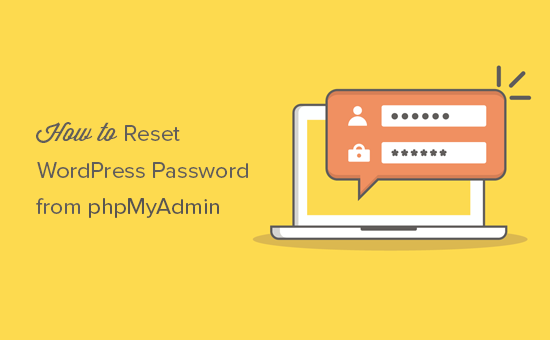
Por que redefinir uma senha do WordPress no phpMyAdmin?
O WordPress facilita muito a recuperação de uma senha perdida.
Basta acessar a tela de login do seu site WordPress e clicar no link “Esqueceu a senha?
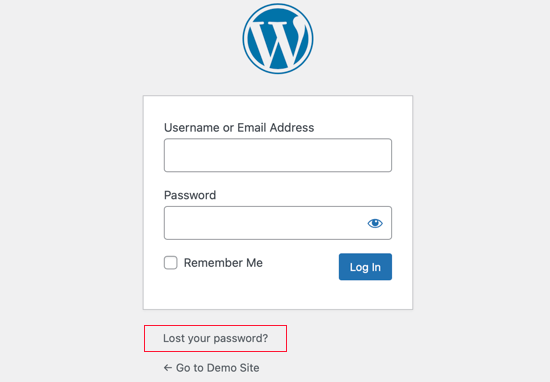
Ao clicar no link, você será levado à página de redefinição de senha. Depois de inserir seu nome de usuário ou endereço de e-mail, o WordPress enviará um link de redefinição de senha para o endereço de e-mail associado.
No entanto, se você não tiver acesso a esse endereço de e-mail ou se o seu site WordPress não enviar um e-mail, não será possível redefinir sua senha.
Nessa situação, você precisará redefinir a senha do WordPress diretamente no banco de dados. A maneira mais fácil de fazer isso é usar o phpMyAdmin.
Dito isso, vamos ver como você pode redefinir facilmente uma senha do WordPress no phpMyAdmin.
Como redefinir uma senha do WordPress no phpMyAdmin
Se não quiser assistir ao tutorial em vídeo, você pode continuar lendo a versão em texto abaixo.
Primeiro, você precisa fazer login no painel do cPanel da sua conta de hospedagem do WordPress. Em seguida, navegue até a seção Databases (Bancos de dados), onde poderá clicar no ícone phpMyAdmin.
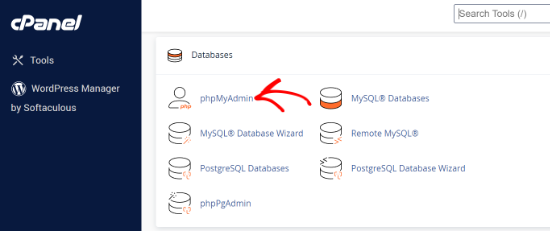
Isso iniciará o aplicativo phpMyAdmin.
Aqui, você precisa selecionar o banco de dados do WordPress no painel esquerdo.
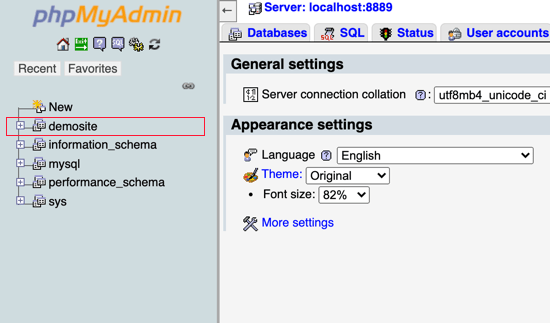
Agora você verá a lista de tabelas no banco de dados do WordPress.
Você precisa procurar a tabela wp_users nessa lista e clicar no link “Browse” (Procurar) ao lado dela.
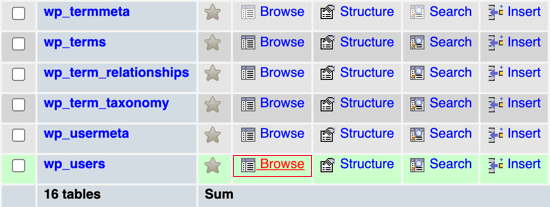
Observação: Os nomes das tabelas no seu banco de dados do WordPress podem ter um prefixo diferente daquele que estamos mostrando em nossa captura de tela. Alterar os prefixos das tabelas pode aumentar a segurança do seu site WordPress.
Agora você verá as linhas na tabela de usuários do WordPress. Vá em frente e clique no botão de edição ao lado do nome de usuário cuja senha você deseja alterar.
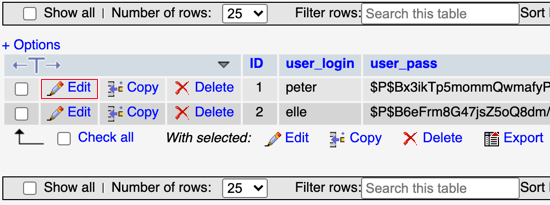
O PhpMyAdmin mostrará um formulário com todos os campos de informações do usuário.
Você precisará excluir o valor do campo user_pass e substituí-lo pela sua nova senha. Na coluna function (função), selecione MD5 no menu suspenso e clique no botão Go (Ir) na parte inferior do formulário.
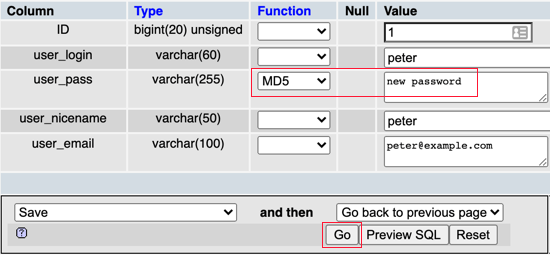
Sua senha será criptografada usando o hash MD5 e, em seguida, será armazenada no banco de dados.
Parabéns! Você alterou com êxito sua senha do WordPress usando o phpMyAdmin.
Alguns de vocês podem estar se perguntando por que selecionamos o hash MD5 para criptografar a senha. O WordPress usava anteriormente o hash MD5 para criptografar senhas, mas desde o WordPress 2.5 ele vem usando tecnologias de criptografia mais fortes.
No entanto, o WordPress ainda reconhece o MD5 para oferecer compatibilidade com versões anteriores. Assim que você fizer login usando uma cadeia de senhas armazenada como um hash MD5, o WordPress a alterará automaticamente para usar os algoritmos de criptografia mais recentes.
Guias especializados sobre senhas no WordPress
Agora que você sabe como redefinir uma senha do WordPress no phpMyAdmin, talvez queira ver outros artigos relacionados a senhas no WordPress.
- Como alterar sua senha no WordPress (guia para iniciantes)
- Como redefinir as senhas de todos os usuários no WordPress
- Como personalizar a página de redefinição de senha do WordPress
- Como forçar os usuários a alterar as senhas no WordPress – Expire Password
- Esqueceu a senha? Como recuperar uma senha perdida no WordPress
- Como forçar senhas fortes para usuários no WordPress
- Como adicionar a autenticação de dois fatores no WordPress (método gratuito)
- Como permitir que os usuários ocultem/mostrem senhas na tela de login do WordPress
- Como gerenciar senhas de forma fácil e segura (Guia para iniciantes)
Esperamos que este tutorial tenha ajudado você a aprender como redefinir uma senha do WordPress no phpMyAdmin. Talvez você também queira ver nosso guia passo a passo definitivo de segurança do WordPress para manter seu site seguro ou nossa seleção de especialistas de plug-ins obrigatórios.
Se você gostou deste artigo, inscreva-se em nosso canal do YouTube para receber tutoriais em vídeo sobre o WordPress. Você também pode nos encontrar no Twitter e no Facebook.





Prescott Chartier
I’ve tried this several times and each time it still says the password is incorrect, and yes I have the correct database.
WPBeginner Support
The next thing to check would be that the MD5 action is properly going through in your database or if it gives you an error.
Admin
Moinuddin Waheed
Changing password by clicking lost or forget password and then getting an email is an easy step.
Using phpmyadmin for changing password is a bit developer oriented.
I have used while developing sites from local host by flywheel but I fear doing for the live server.
Do we have the same encryption after changing password as it was before or it is simply the hard coded text that we typed in as password?
WPBeginner Support
If you are using the phpMyAdmin method you would want to put in your password normally and in the function dropdown you would set it to MD5 to have the password be the text you placed in the field.
Admin
Laxman
Thank You very much…
WPBeginner Support
You’re welcome
Admin
Branson
Hi,
I have just tried to reset my password with the MD5 method you suggested, but it didn’t work. I tried like 5 times and every time I tried to login into my website it would say incorrect password. What’s wrong?
Thanks in advance.
WPBeginner Support
If you have more than one WordPress installation on your hosting provider, ensure you are editing the correct database and ensure you apply the changes in the database for the most common reasons.
Admin
Stem
Hello,
I tried to reset my password using this method, but it’s showing this error “Error: The username user is not registered on this site. If you are unsure of your username, try your email address instead.”
WPBeginner Support
That would normally mean your username is not on the site, you would want to ensure are logging in with the correct username or email address. The steps in this article should not affect your username or email.
Admin
Brett
MD5 pushed it through. Thank you!
WPBeginner Support
You’re welcome! Glad our guide was helpful
Admin
blossominglotus
This method is not working for me. I even tried updating the password using raw SQL. It does change the password but I still cannot log in with the new password.
WPBeginner Support
If this method is not working then we would recommend reaching out to your hosting provider and/or checking that you are editing the correct database on your hosting provider if you have more than one database.
Admin
Guillaume Frasca
Hi, I followed your advice, but when I click on Go, I have the #1142 error message “UPDATE command denied to user ‘scienceisa431’@’@XX.XX.XX.X’ for table ‘mod597_users’
Is there a way around this?
WPBeginner Support
Your user may not have proper access on your hosting environment, if you reach out to your hosting provider they should be able to assist!
Admin
James Wallis
Saved my skin with this–thank you so much.
WPBeginner Support
Glad our guide was helpful!
Admin
Joseph
Thanks for the good job
I was able to locate and change my WordPress details with this tutorial
WPBeginner Support
Glad our guide could help!
Admin
Randy
I tried this and I got a white screen on my website. Please help
WPBeginner Support
Changing your password shouldn’t cause that specific issue, there is a good chance a plugin may have had a conflict. You would want to follow our guide below for how to fix the white screen error:
https://www.wpbeginner.com/wp-tutorials/how-to-fix-the-wordpress-white-screen-of-death/
Admin
Syed Waris
Thank you so much.
The article was very helpful for me.
WPBeginner Support
Glad our guide was helpful!
Admin
NS
Thanks! The “MD5” encryption step is what I was missing when I tried to reset. Then I came across your article and tried it and it worked! You just saved me hours and hours of time and a potentially angry client.
aisha
I tried this but didn’t work. Need help
WPBeginner Support
If your changes are not staying, you would likely want to check with your hosting provider to ensure you’re not running into a security tool blocking your change. Another common issue would be if you have a staging site or an old database for a previous site so you would want to ensure you are changing the information for your correct site.
Admin
Altuğ G.
This didn’t work for me
WPBeginner Support
It would depend on what part didn’t work. The most common reasons would be if you did not save your changes or did not convert to MD5
Admin
Pakodev
Thanks! It worked.
WPBeginner Support
Glad our guide was able to help
Admin
Arsène
It worked, thank you very much
WPBeginner Support
Glad our guide could help
Admin
Aikya Dasgupta
Thank you very much. This worked for me and I am now able to access my WordPress dashboard.
WPBeginner Support
Glad our guide was helpful
Admin
John
Perfect – saved me from a big issue.. thanks! Now, about getting those WP system emails working again…………….!
WPBeginner Support
If you’re not receiving the emails, we would recommend setting up SMTP on your site:
https://www.wpbeginner.com/plugins/how-to-send-email-in-wordpress-using-the-gmail-smtp-server/
Admin
Tayyab Shafique
it was really helpful.
Thanks
WPBeginner Support
You’re welcome
Admin
Saad
thanks a lot for saving my day …
WPBeginner Support
You’re welcome
Admin
Anita
Thank you, this saved me a headache
WPBeginner Support
Glad our guide was helpful
Admin
Elias
You’re a genius. Thank you
WPBeginner Support
You’re welcome
Admin
jackie
REALLY helpful. I’ve been struggling for weeks and now i can finally log in again! thanks a lot!
WPBeginner Support
You’re welcome, glad our guide was helpful
Admin
Robin B
So, so helpful. Thanks so much!
WPBeginner Support
You’re welcome
Admin
Chidi Ejikeugwu
why did you recommend to use MD5 when changing password?
WPBeginner Support
That is what WordPress uses for passwords by default
Admin
japsimran singh
Thank You Buddy.
It really helped.
WPBeginner Support
Glad our article could help
Admin
banson
Thank you problem Solved
WPBeginner Support
Glad our guide was helpful
Admin
Nthtuko Mbhele
Thank you so much, thank you, thank you
WPBeginner Support
You’re welcome, glad our guide was helpful
Admin
Premier
Thank you! Solved my problem!
WPBeginner Support
Glad our guide was able to help
Admin
Yann
Worked wonders, thanks!
WPBeginner Support
You’re welcome, glad our guide was able to help
Admin
Marco
thank you!!!!!!
WPBeginner Support
You’re welcome
Admin
Anand
Did not work for me.
WPBeginner Support
You may want to ensure you set the password to MD5 and that you are editing the correct user file if you have multiple WordPress sites or users
Admin
Pranoy
very very thank you
big headache solved
WPBeginner Support
Glad our guide could be helpful
Admin
Urs Keller
You did super great job. I could reset my pw. Thank you!
WPBeginner Support
You’re welcome, glad we could help
Admin
Taylor
I have followed these steps and the password was generated however, whenever I put in the password it still says it is incorrect.
Any help you can provide ?
WPBeginner Support
You would want to double-check that you encrypted the password using MD5 as the most common reason
Admin
Cattel
Direct explanation! Thanks!
WPBeginner Support
You’re welcome
Admin
Hazel Pan
Thank you for this noob-friendly guide! I was able to understand how to fix my issue right away. It also helped that I had awesome support from my hosting provider, Namecheap.
WPBeginner Support
Glad our guide could be helpful
Admin
Terry
Thank you so much for this article, it helped.
WPBeginner Support
Glad our article was helpful
Admin
Umar Gondal
May Allah bless you with eman. This article helped me to reset password of my website. Very informative article
WPBeginner Support
Glad our article could be helpful
Admin
Ajit Kumar
The email could not be sent. Possible reason: your host may have disabled the mail() function.
error shows
WPBeginner Support
If you have that error on your site, you would want to start by reaching out to your hosting provider.
Admin
George
Great article, I can see how this “can” work, but didn’t work for us either!!!!! We have access to the registrar, access to the domain and web hosting, full access to file manager, phpMyAdmin and the Installatron.
Followed your instructions to the T, didn’t work. We even changed the email in the email field. Its like the script didn’t update.
WPBeginner Support
If this method didn’t work then you likely need to reach out to your hosting provider and your host should be able to assist in fixing this issue.
Admin
Donny
Really helpful, thanks a lot.
WPBeginner Support
You’re welcome
Admin
zorax
Thank you, it was really helpful!
WPBeginner Support
You’re welcome
Admin
Van
This didn’t work for me. I’ve tried changing my password via my profile in WP Admin and using this technique; neither worked. WordPress 5 bug?
WPBeginner Support
You may want to clear your cache on your site and browser and check with your hosting provider that they are not preventing changes to your site’s database.
Admin
Ammar Falak
It didn’t work for us. I am still locked out of my WordPress Account. Please help!
WPBeginner Support
If this method does not work, if you reach out to your hosting provider they should be able to help you log back into your site.
Admin
Sanyukta Khot
Thank you for a very useful article! Saved me a lot of time!
WPBeginner Support
You’re welcome
Admin
Dee
Awesome!! Thanks so much for the valuable information.
Please continue to help us newbies…
WPBeginner Support
Glad our articles are helpful
Admin
lordhunos
Wow, it works! You made my day! Thank you very much!
WPBeginner Support
Glad our article could help
Admin
Boitumelo
This was very very helpful.
Thank you very much
WPBeginner Support
Glad it was helpful
Admin